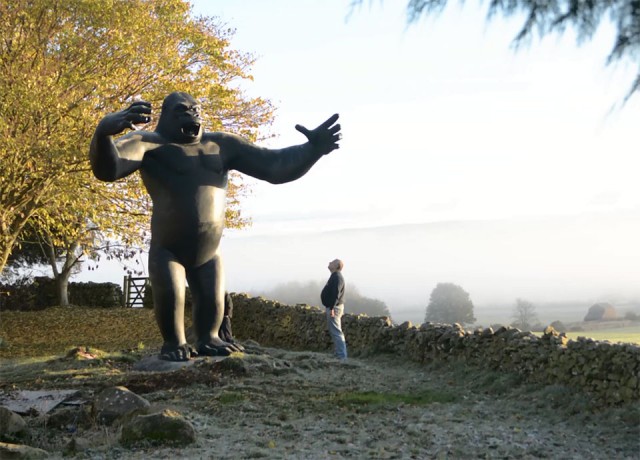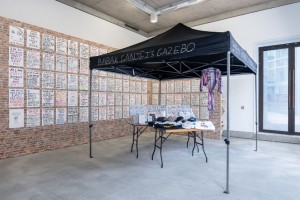What Makes Public Art Successful? Reflections On City Sculpture Projects 1972
“Is part of the power of the legacy of this project because the sculptures didn’t stay?” Four decades since its commission, Anna McNay speaks to the artists involved in a ground-breaking British public art programme, which has recently been reappraised at the Henry Moore Institute, Leeds…
What defines a successful art project? One where the works all sell? Or one where public opinion is changed and a new form of acceptance is born? In 1972, the Peter Stuyvesant Foundation launched City Sculpture Projects, an ambitious endeavour that led to the installation of public sculptural works by 14 artists in eight cities in England and Wales, for a period of six months. A towering five-metre-tall King Kong in Birmingham, a revolving cone in Plymouth, and a conceptual enquiry in Cardiff were among the commissions realised – but many deemed the project a failure, since none of the works was acquired by its respective local council, and all were accordingly removed at the end of the six-month run.
Nevertheless, the project has had a lasting impact. “It was the moment when sculpture everywhere, but particularly in Britain, became recalibrated,” says Lisa Le Feuvre, Head of Sculpture Studies at the Henry Moore Institute (HMI), Leeds, where an exhibition has recently been held commemorating the artistic and social experiment. “What we love more than anything [at the Institute] is contesting possibilities of sculpture. The ambition of the 1972 project was to show cutting-edge sculpture, outside of London, at a street level, city-oriented and also viewer-oriented.”
At the time, the project was well-served by the art journal Studio International, which ran a 14-page special issue, featuring texts by the artists involved, including some whose commissions were not ultimately realised. These pages were on display during HMI’s recent exhibition, alongside cuttings from local newspapers, photographs, a slide show of footage and maquettes – some remade especially for the show. Outside the Institute, the colossal King Kong towered ominously, attracting visitors, firstly for a selfie, and then, with any luck, through the gallery doors.
The artist behind the enormous ape is Nick Monro (b. 1936), now a reclusive physicist, living in a cottage in Dorset, with no hot water or electricity. His research into perpetual motion seeks to disprove Newton’s Third Law. At the time, however, when briefed to produce a “city-oriented” work, he decided, in a deliberately facetious manner, to make King Kong, as a “city-disoriented” response. Built out of fibreglass, the huge creature was scaled up from a tiny maquette, entirely by using a tape measure and squinting. After his stint in Birmingham, it lived for three years with a used car dealer, before moving to Edinburgh and then the Lake District, from where it ventured for the first time for this exhibition, and now has returned.

Liliane Lijn’s (b. 1939) six-metre-high revolving steel cone, cut through with layers of Perspex sheet and neon, was born out of her thinking around cosmological phenomena. “You can never finish a point,” she says. “It goes on to infinity.” For this reason, she blunts the point of her cone, making it parallel to the base and to Earth. The lit up elliptical lines are like planetary trajectories. Lijn remembers how people kept asking her what her work was in aid of, not quite grasping the concept that it was “just” art. After Plymouth, White Koan was shown for six months on the terrace outside the Hayward Gallery, London, then at the Globe Theatre, before finally being purchased by the University of Warwick. “It’s very popular now. I don’t want to be immodest, but it’s really captured the imagination of the students. They really own it. They have a Koan site on Facebook and on Twitter.”
Garth Evans (b. 1934), whose 12-metre-long steel construct was intended to speak to Cardiff’s industrial roots, was brave enough to loiter, the day after installation, and take a microphone around asking people for their opinion of his work. He made a point not to refer to it as “sculpture” or a “work of art”, asking only: “What do you think of this?” Similarly to Lijn’s experience in Plymouth, the Cardiffians were struggling to come to terms with what this actually was, many deeming it “rubbish”. The recordings formed part of the retrospective exhibition at the HMI and have also been used by Evans since to create a tongue-in-cheek work in which the sounds emanate from a rubbish bin, as well as being published in a book and turned into a stage production.

In 1972, there was no follow-up to or evaluation of this ambitious project, and Le Feuvre, and curator, Jon Wood, see that as the role of this HMI exhibition – albeit some 45 years after the event. This time-lapse, however, might be seen to attest to the power and lasting legacy of the project, which, if not an obvious across-the-board success, certainly opened up discussions about the role – and mere existence – of abstract art in the public realm. Some may not have seen the point, but the few who did set the ball rolling. One archive newspaper cutting tells, for example, of the lollipop lady in Birmingham who donated £1 to a campaign to save King Kong.
“Is part of the power of the legacy of this project because the sculptures didn’t stay?” ponders Le Feuvre. Had they been seen every day since, become part of the furniture, as it were, perhaps their potency would have faded. But by living on solely in the memory of those who witnessed them, they have gained a certain status, as symbols of change. “Had they been there longer, people would have grown fonder,” posits Lijn. And this has certainly been attested to by the response of Warwick students to the potential removal of White Koan – they went on strike! It will be interesting to see how the public responds to the removal of King Kong from outside the HMI at the end of this exhibition. While we often might not notice something until it has gone or is under threat, this is one public sculpture which has consistently drawn a crowd.
Anna McNay
Anna saw City Sculpture Projects 1972 at the Henry Moore Institute, Leeds, 24 Nov 2016–19 Feb 2017
Read more about this project via this thoughtful bibliography, courtesy HMI
Video, top: City Sculpture Projects 1972 – The Henry Moore Institute. from Rogue Robot on Vimeo. All other images courtesy Henry Moore Institute





